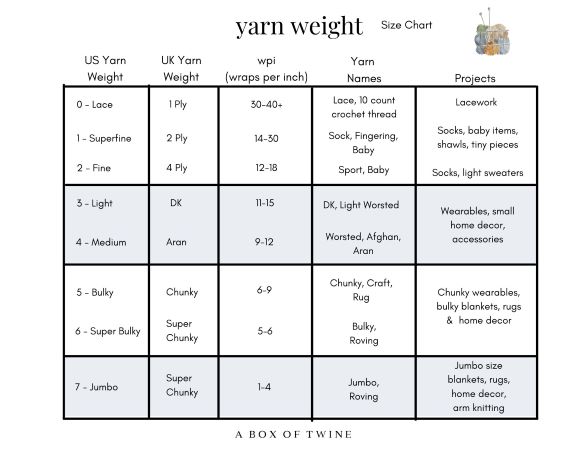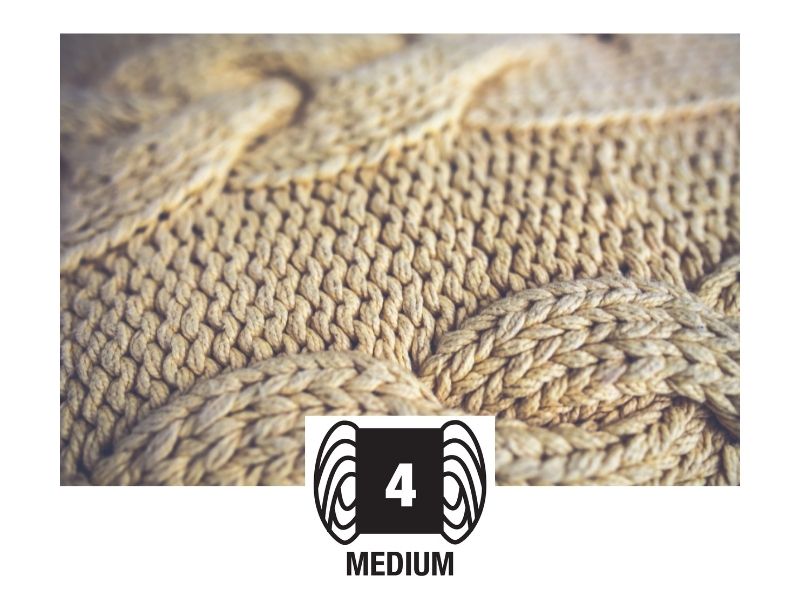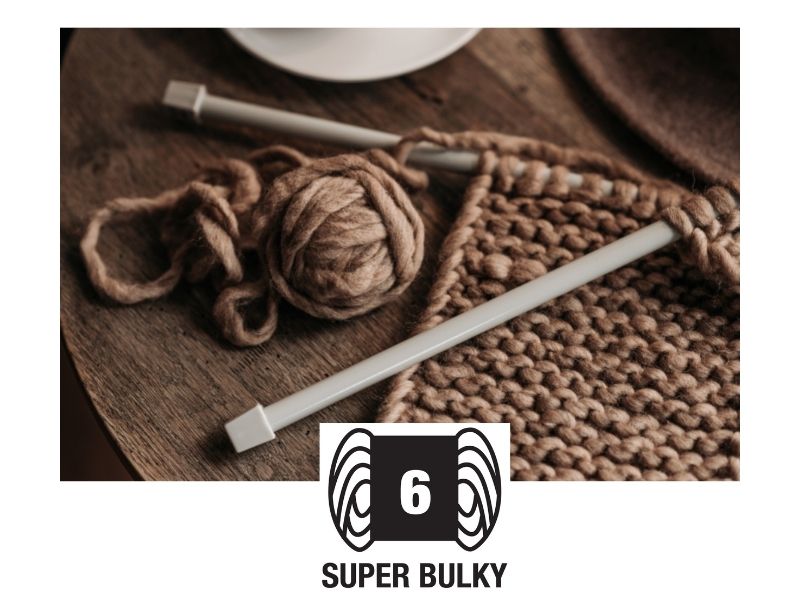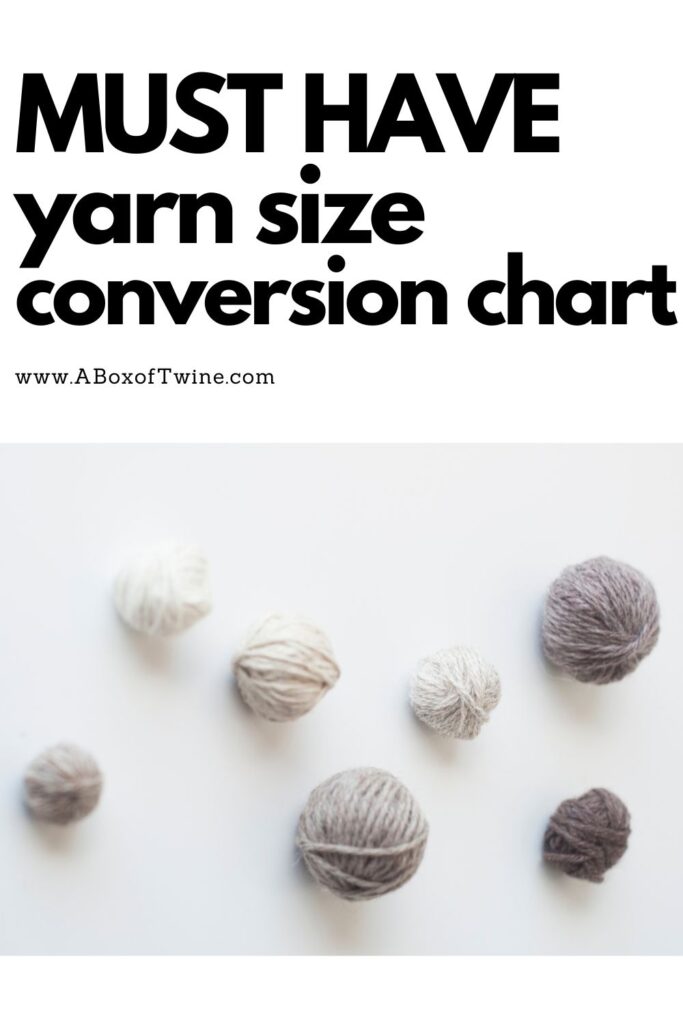
Yarn Size Chart {FREE Printable}
Are you just learning to knit or crochet? Do yarn sizes have you stumped? You may have fallen in love with the color or texture of a particular yarn but wonder about its size. It is critical to understand the various yarn sizes and which projects they are best used for. A handy yarn weight chart (aka yarn size chart) may be your go-to guide as you get acquainted with the wonderful world of yarn. Keep reading for more information on the various sizes of yarn and get my FREE printable for a yarn size chart…
How do I know what YARN to use?
When you just starting out to knit or crochet, it may be tempting to just grab any old yarn and get to it. You may think that yarn sizes don’t matter much if you just love the color of the yarn. (I may have been guilty of this thought process in the past). 😊
You may also have purchased a knitting book or digital knitting pattern, then wondered how to interpret the ‘yarn size’ you are instructed to use. This can be especially daunting if the size is listed as a number.
How on earth can you decipher what they are asking? You first need to know what yarn size (aka yarn weight) is. Yarn size/weight refers to the thickness of the yarn, which is relevant to how your final project will come out.
It is very helpful to have a yarn weight conversion chart on hand to understand the various terms used for yarn size.
YARN size chart
The first thing you will need to understand about yarn is that there are different numbers used to identify their size if you are based in the United States (US) vs. names in the United Kingdom (UK).
The standard US yarn sizes run from 0 (for thinnest yarn) to 7 (for thickest). These numbers were determined by the US Craft Yarn Council and help to identify the various weight categories.
In contrast, the UK yarn sizes do not have a numbering category. Various names are used to identify the different yarn weights.
A useful yarn size conversion chart will list both sets of identifying numbers and names so that you can interpret which size you need for a project.
YARN SIZE CHART PRINTABLE
I have this helpful FREE printable for a yarn size conversion chart to assist you in deciphering these yarn weights.

How do I convert yarn sizes?
If a knitting pattern calls for a yarn size in UK terms and you are using US yarn, you can quickly scan the chart to determine the translation to the US weight number category.
Conversely, if a knitting pattern you want to try has a US number yarn size listed, but you always use UK terms, the translation can work the other way.
** The key thing to remember when you are substituting yarns for a pattern is to TEST YOUR GAUGE. Manufacturers can vary on how their yarn is produced, so it is best to test out the pattern gauge if you don’t plan on using the exact same yarn specified for a pattern.
One more BONUS feature of my free chart is that it also gives you the common YARN NAMES and PROJECTS recommended for various groups of yarn sizes. Light weight yarns work best for smaller projects, whereas heavier weight yarns work best with bulky projects.
Get your yarn weight chart printable by subscribing to A Box of Twine. The yarn weight chart is part of freebies for both KNITTING and CROCHET supplies. Choose a link below to grab your freebie:
This chart will help you answer a wealth of questions, such as those listed below…
Knitters and crocheters ask: what do yarn sizes mean?
When you are new to knitting or crochet, you may find all the various yarn sizes confusing. Here are some answers to beginner questions that I hope will help you along your crafting journey.
First, questions on how to read this free chart –
What are the different weights of yarn?
Another way to phrase the question is, “What are the different yarn sizes?” The US standard yarn weights are listed as: 0 for Lace, 1 for Superfine, 2 for Fine, 3 for Light, 4 for Medium, 5 for Bulky, 6 for Super Bulky, and 7 for Jumbo. You can find all these terms in the leftmost column of the chart. The 2nd column contains corresponding names/types for the same yarn in UK sizes. The 3rd column identifies common wpi for each yarn size (see more on wpi below). The 4th column shows the typical names used for these same yarns. Lastly, the 5th column contains suggestions for projects that would work well for each yarn size.
Here’s an example where you can use the chart to convert – a pattern calls for a yarn in size 4 (Medium), and you want to know if you already own this size as part of your yarn collection. Simply locate the 4-Medium under the ‘US Yarn Weight’ column on the chart, then look in the next column under ‘UK’ size numbers and you will find the name ‘Aran’. You will also notice that the 4th column also references typical names for this size – Worsted, Afghan, or Aran. The packaging on your yarn will contain any of these symbols and/or names, so you’ll know you have the right size.
What do yarn weight numbers mean?
The numbers 0-7 are in the first column of my chart. These numbers were created by the US Craft Yarn Council to have a helpful order to the various size weights of yarn, from thinnest to thickest.
Each category represents a specific weight of yarn, which can also be determined by wpi – ‘wraps per inch’. This number represents how many wraps of the yarn you can make around an object with a consistent circumference, such as a pencil, measured over 1 inch. Basically, it gauges how thick the yarn is. The wpi’s for each category go from high numbers for thin yarn to low numbers for thick yarn.
Next, some beginner-friendly questions about yarn –
How can you tell the weight of yarn on the package?
Nowadays, the packaging on US yarn always contains a large symbol with the numbers representing the yarn weight category. The symbol will appear as one of the following graphics on the yarn package:

Simply read the back of your yarn package to determine which size it is.
What is Lace yarn?
Lace yarn, size 0, is the thinnest yarn. It can have 30-40+ wpi and is best used for delicate lace projects, such as doilies.

What is Superfine yarn?
Superfine yarn, size 1, is also very thin. It is usually measured at 14-30 wpi and can be used for light socks, baby items, and delicate ornaments & shawls.
What is Fine yarn?
Fine yarn, size 2, is the next size up at 12-18 wpi. Fine yarn can be used for socks, baby items, and lightweight sweaters.
What is Light yarn?
Light yarn, size 3, can be measured at 11-15 wpi. Light yarn is just slightly thinner than Medium yarn, and it can be useful for many projects. Lightweight hats, gloves, shawls, and sweaters are good projects for this size.
What is Medium yarn? (related question: What size yarn is size 4?)
Medium Yarn, size 4, is the most common and popular size. It is often known as worsted weight, or Aran. There is a wealth of uses for this common size, such as sweaters, hats, mittens, scarves, home décor, etc. It usually has 9-12 wpi.
This size yarn is also the best to use for textured stitch patterns, such as cables. It is not too thin or thick that you cannot see the details of the stitch pattern. This medium size is ideal for showcasing interesting stitch patterns.

What is Bulky yarn?
Bulky Yarn, size 5, is a bit chunkier than Medium and can often be confused with that size. It normally has 6-9 wpi.
** If a pattern calls for Bulky yarn, you may want to double check the gauge with the yarn you plan to use. Some yarns that are labelled as ‘Bulky’ or ‘Chunky’ are actually closer to Medium size.
What is Super Bulky yarn?
Super Bulky, size 6, is one of my favorite sizes to work with. What can I say? I prefer to work things up quickly, and this thick yarn takes much less time to knit/crochet than the thinner yarns. The downside is that your final piece is, of course, BULKY. But that is a great look for chunky sweaters, hats, and scarves! This size normally measures 5-6 wpi.

What is Jumbo yarn?
The final size, Jumbo (7), is also a fun yarn size to work with. If you want to make a huge chunky blanket or pillow cover, this size is fabulous for home décor. You can even use your arms to knit with this big yarn! Expect to measure the yarn at as little as 1-4 wpi.

How do I know my yarn size if I lost the label?
If you have a yarn stash that is, ahem, a bit disorganized, you may be missing some original packaging labels. But don’t panic. You can figure out your yarn’s size without consulting the label.
Simply wrap the yarn around a pencil for a few inches, with each strand side-by-side. Wrap the yarn close together, without overlapping it. Next, carefully measure how many wraps per inch (wpi) at various places on the pencil. Use that answer to determine the size based on my free chart (wpi for each size). Easy!
Yarn Patterns and Projects
You may also be wondering, what yarn is best for which projects? As you can see from the free printable of the yarn weight guide, yarn in the thinner sizes is best used for airy or tiny yarn projects. Examples of these are lace work, socks, tiny ornaments, and baby attire/accessories.
Moving up the yarn size chart, there are a plethora of projects for Light or Medium weight yarn. Use this size yarn for popular projects like hats, sweaters, mittens, scarves, wraps, throws, home goods, etc.
Lastly, the bulky and jumbo yarn projects are terrific for thicker sweaters, blankets, baskets, pillows, rugs, and such. Jumbo size yarns are also perfect for arm-knitting, where you use your ARMS to knit!
Find some of my beginner-friendly patterns using a variety of yarn sizes here…
Grab more beginner-friendly patterns in my ETSY SHOP.
Final Thoughts about YARN SIZES
I hope my free printable for a yarn size conversion chart will help you navigate the choices for various size yarns. It is my genuine desire to be a cheerleader for beginner knitters & crocheters, and any time I can mitigate any confusion is a welcome opportunity.
I would love to hear if this yarn size chart has helped you – let me know in the comments!
Visit the KNITTING and CROCHET categories on my blog to find more goodies!
And check out my favorite types of yarn for various seasons:
===> Remember to PIN for later! <===



2 Comments
Peg Abendroth
I love your blogs!
Susan
Thanks so much Peg! I really appreciate your visit. 🙂